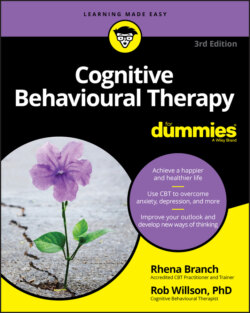Читать книгу Cognitive Behavioural Therapy For Dummies - Rob Willson - Страница 48
Testing Out Predictions
ОглавлениеWhen testing out your predictions, strive to get unambiguous disconfirmation, in so far as you can. Unambiguous disconfirmation means discovering conclusively that your fears don’t come true, whether or not you actually do something to prevent them occurring. An example of unambiguous disconfirmation may be finding out that your dizziness is caused by anxiety, and that you won’t collapse even if you don’t sit down or hold on to something.
Go through the following four steps to devise a behavioural experiment:
1 Describe your problem.Write down the nature of your problem and include your safety behaviours (things you do to try to prevent your feared catastrophe – head to Chapter 7 for loads more on safety behaviour). Phrase the problem in your own words and make a note of how the problem negatively affects your life.
2 Formulate your prediction.Decide what you think will happen if you try out a new way of thinking or behaving in real life.
3 Execute an experiment.Think of a way of putting a new belief or behaviour to the test in a real-life situation. Try to devise more than one way to test out your prediction.
4 Examine the results.Look to see whether your prediction came true. If it didn’t, check out what you’ve learned from the results of the experiment.
You can rate the degree to which you believe a prediction will come true on a percentage between 0 and 100 at the start of your experiment. After you’ve done the experiment and processed your results, re-rate your conviction in the original prediction.
Take care not to use subtle ways of keeping your feared catastrophe at bay, such as doing experiments only when you feel ‘right’, are with ‘safe’ people, have safety signals to hand (such as a mobile phone or a bottle of water), or are using safety behaviours (such as trying to control your anxiety with distraction or by gripping tightly to your steering wheel). Using these subtle safety measures during your exposure to a fear can leave you with the impression that you’ve had a narrow escape, rather than highlighting that your predicted fear didn’t come true.
For example, consider the following experiment, which Nadine initiates to examine her fear of rejection and social anxiety:
Describe the problem. Nadine’s afraid of people thinking negatively of her and of being rejected by her friends. In social situations, Nadine monitors her body language and censors what she says, taking great care not to express any strong opinions in case others disagree with her. She often plans in advance what she’s going to say.
Formulate a prediction. Nadine predicts, ‘If I express an opinion or disagree with my friends, they’ll like me less.’ She rates her conviction in this idea as 90 per cent.
Execute an experiment. For the next six social gatherings Nadine attends, she decides that she’ll speak up and try to offer an opinion. If at all possible, she’ll find a point on which to disagree with someone.
Examine the results. Nadine discovers that no one took exception to her saying more. In fact, two friends commented that it was nice to hear more about what she thought about things. Nadine re-rates her conviction in her original prediction as 40 per cent.
By conducting a behavioural experiment, Nadine observed that her feared prediction – ‘Others will like me less if I express my opinions’ – didn’t happen. This result gives Nadine the opportunity to change her behaviour according to the results of her experiment and, therefore, to speak up more often. It also helps to reduce how much she believes the original prediction. Nadine can now adjust her thinking based on evidence gathered through the experiment.
Nigel used a behavioural experiment to test out his prediction that he wouldn’t enjoy engaging in social activities. Since self-isolating and disengaging from previously enjoyed activities promotes depression, Nigel really needs to understand the benefits of becoming more active. Nigel worked through an experiment as follows:
Describe the problem. Nigel’s depression typically leads to him having gloomy and pessimistic thoughts. He tends to avoid going out with his friends or doing any of his regular hobbies because he doesn’t feel like it these days. He believes that he won’t enjoy himself; therefore, there’s no point in trying any of these activities. (As we note in Chapter 12, self-isolating behaviour is one of the key ways in which depression is maintained.)
Formulate a prediction. Nigel chooses to experiment with the prediction ‘Even if I do go out, I won’t enjoy myself and I’ll end up feeling even worse once I get home.’ He rates his strength of conviction in this thought as 80 per cent.
Execute an experiment. Nigel plans to structure his week and to schedule two occasions to see friends. He also plans to spend two half-hour sessions riding his bike, which he used to enjoy. He rates each day over the next seven days in terms of his mood and of how much he enjoys his activities.
Examine the results. Nigel notices that he does get some enjoyment from seeing his friends, although less than he usually would. Although he doesn’t particularly enjoy his cycling and feels more tired than usual, he notes that he at least felt glad he had done something. He re-rates his conviction in his original prediction as 40 per cent and decides to conduct further experiments to see whether his mood and energy levels improve over the next two weeks if he continues to be more active.
This experiment helped Nigel to see that he felt better for doing something, even if he didn’t enjoy cycling or socialising as much as he would when he wasn’t depressed. Noting these results can help Nigel to stick to a schedule of activity and ultimately help him to overcome his depression.
